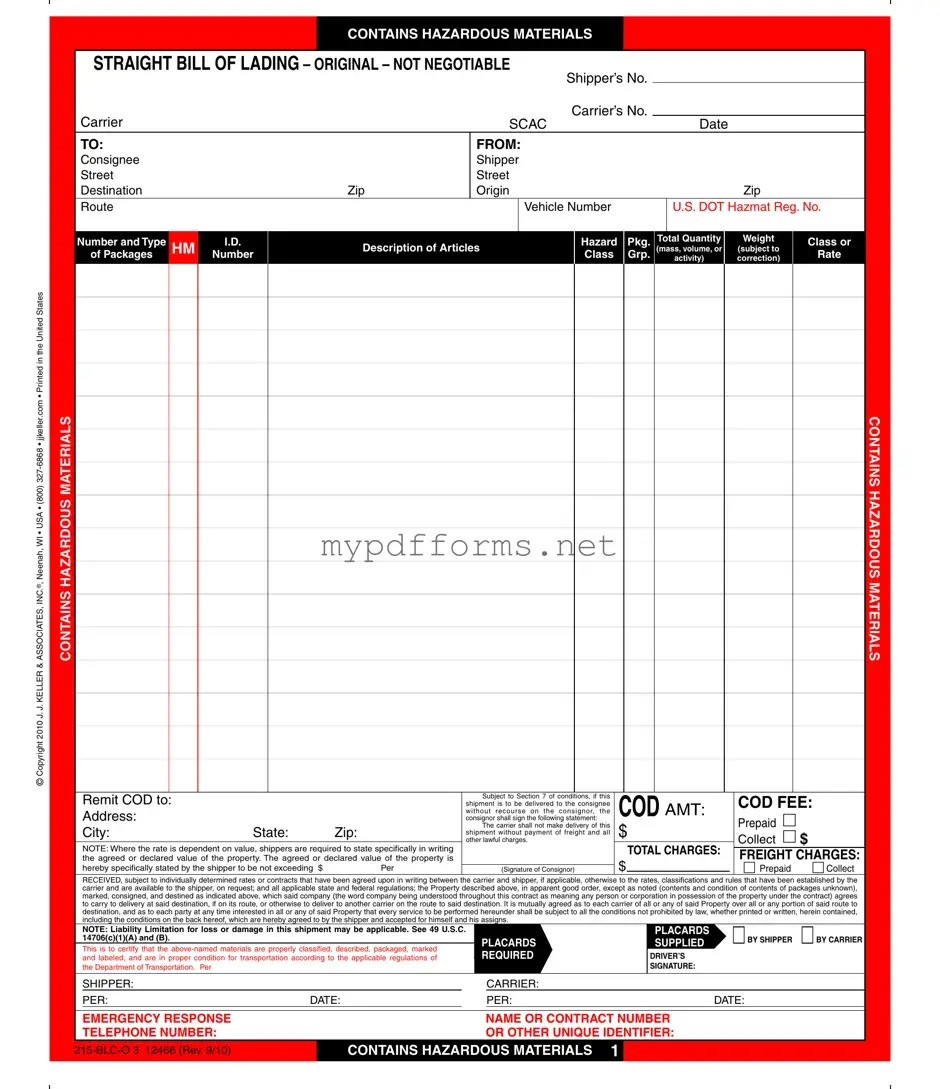The Hazard Bill of Lading form is similar to the standard Bill of Lading, which serves as a receipt for goods and a document of title. Both documents outline the details of the shipment, including the sender, receiver, and contents. However, the Hazard Bill of Lading specifically addresses the transportation of hazardous materials, ensuring compliance with safety regulations. This added layer of detail is crucial for the safe handling and transport of dangerous goods, whereas a standard Bill of Lading may not include such precautions.
Another document that shares similarities is the Freight Bill. This document details the charges for transporting goods and is often used in conjunction with the Bill of Lading. While the Freight Bill focuses primarily on the financial aspects of the shipment, both documents work together to provide a complete overview of the shipping transaction. The Hazard Bill of Lading includes specific information about hazardous materials, which is not typically found in a standard Freight Bill.
The Shipping Manifest is another related document. It lists all the items being shipped and is used to verify that the correct goods are loaded onto a transport vehicle. Like the Hazard Bill of Lading, the Shipping Manifest must include detailed descriptions of the items. However, the Hazard Bill of Lading goes further by ensuring that hazardous materials are properly classified and labeled, which is essential for regulatory compliance and safety during transport.
A Packing List is similar in that it outlines the contents of a shipment. It provides details about the items, including quantities and descriptions. However, while a Packing List is generally used for any type of shipment, the Hazard Bill of Lading specifically highlights the presence of hazardous materials. This distinction is vital for ensuring that all safety protocols are followed during transport.
The Certificate of Compliance is another document that is relevant. It certifies that the goods being shipped meet certain regulatory standards. While the Hazard Bill of Lading includes a statement that the hazardous materials are properly classified and packaged, a Certificate of Compliance provides additional assurance that the items comply with specific safety regulations. This extra documentation can be essential for international shipments or when dealing with particularly dangerous materials.
Similar to the Hazard Bill of Lading is the Dangerous Goods Declaration. This document is required when shipping hazardous materials and provides information about the nature of the goods, including their classification and handling requirements. Both documents aim to ensure safety during transport, but the Dangerous Goods Declaration is often more focused on regulatory compliance, while the Hazard Bill of Lading serves a broader purpose in the shipping process.
The Air Waybill is another document that resembles the Hazard Bill of Lading, especially when shipping hazardous materials by air. It acts as a contract between the shipper and the airline, detailing the shipment's contents and destination. The Hazard Bill of Lading, while primarily used for ground transport, shares similar functions in ensuring that hazardous materials are handled correctly during transit.
The Customs Declaration is also relevant, particularly for international shipments. This document provides details about the goods being imported or exported, including their value and classification. While the Hazard Bill of Lading ensures safe transport of hazardous materials, the Customs Declaration focuses on compliance with customs regulations. Both documents are essential for smooth shipping processes, especially when hazardous materials are involved.
For those involved in motorcycle transactions, it is vital to understand the importance of proper documentation to facilitate smooth ownership transfers. The Arizona Motorcycle Bill of Sale form is an essential legal document that articulates the sale of a motorcycle, ensuring all pertinent details regarding the transaction are accurately recorded. To learn more about this vital form, visit motorcyclebillofsale.com/free-arizona-motorcycle-bill-of-sale, which provides resources to simplify the process for both buyers and sellers.
The Pro Forma Invoice is another document that can be similar in function. It provides an estimate of the costs associated with a shipment, including shipping fees and taxes. While it does not specifically address hazardous materials, it is often used in conjunction with the Hazard Bill of Lading to provide a complete picture of the transaction. Both documents are important for financial transparency and ensuring that all parties are aware of the costs involved in shipping.
Lastly, the Delivery Receipt is similar in that it serves as proof of delivery for the shipped goods. It confirms that the items have arrived at their destination and are in the expected condition. While the Hazard Bill of Lading includes details about the shipment, the Delivery Receipt focuses more on the completion of the shipping process. Both documents are vital for maintaining accurate records and accountability throughout the shipping journey.
